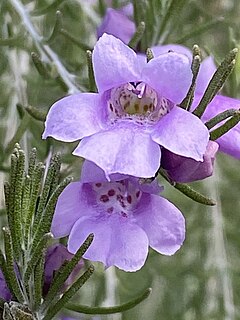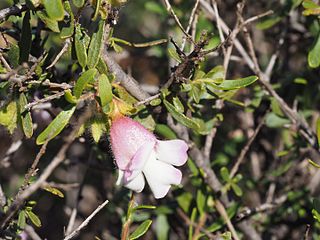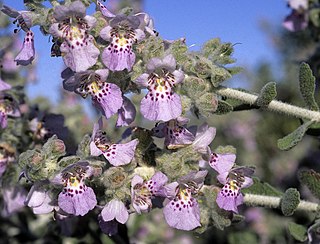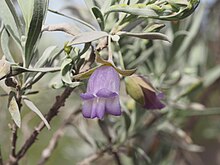
Eremophila mackinlayi, commonly known as desert pride, is a flowering plant in the figwort family, Scrophulariaceae and is endemic to Western Australia. It is a shrub with its branches and leaves covered with a thick layer of yellow to grey hairs, mostly egg-shaped leaves and deep lilac-coloured to purple flowers. It is most closely related to E. strongylophylla and E. hygrophana and sometimes occurs in the same areas as these species.

Eremophila strongylophylla is a flowering plant in the figwort family, Scrophulariaceae and is endemic to Western Australia. It is a small shrub with distinctive round leaves, yellowish new growth and purple flowers which are white inside. It is similar to Eremophila mackinlayi and Eremophila hygrophana but distinguished from them by characteristics including leaf shape, and the type of hairs on its leaves and branches.

Eremophila microtheca, also known as heath-like eremophila, is a flowering plant in the figwort family, Scrophulariaceae and is endemic to Western Australia. It is an erect shrub with densely hairy branches and leaves, narrow leaves and pale lilac-coloured flowers and which emits a strong odour.
Eremophila congesta is a flowering plant in the figwort family, Scrophulariaceae and is endemic to a small area in central areas of Western Australia. It is a grey-coloured shrub with crowded, hairy leaves and lilac-coloured flowers which are white inside.

Eremophila lachnocalyx, commonly known as woolly-sepaled eremophila, is a flowering plant in the figwort family, Scrophulariaceae and is endemic to Western Australia. It is an erect, spreading shrub with densely hairy, greyish leaves but its most distinctive feature is its densely woolly sepals.

Eremophila lanceolata is a flowering plant in the figwort family, Scrophulariaceae and is endemic to Western Australia. It is a low, spreading shrub with foliage which is shiny when young, angular branches and lilac to purple flowers and which grows in the north-west of Western Australia.

Eremophila obovata is a flowering plant in the figwort family, Scrophulariaceae and is endemic to Australia. It is a low, compact shrub with lilac to purple flowers growing mainly in the Northern Territory and Queensland but also Western Australia, South Australia and New South Wales.

Eremophila pantonii, commonly known as broombush, is a flowering plant in the figwort family, Scrophulariaceae and is endemic to Western Australia. It is a broom-shaped shrub with narrow leaves which have a hooked tip, and blue or purple, sometimes white flowers in winter and spring.
Eremophila petrophila is a flowering plant in the figwort family, Scrophulariaceae and is endemic to Western Australia. It is a tall, erect, open shrub with rough branches, narrow, sticky leaves and pale lilac-coloured flowers.

Eremophila phyllopoda is a flowering plant in the figwort family, Scrophulariaceae and is endemic to Western Australia. It is an erect or spreading shrub, sometimes round or flat-topped with sticky, hairy leaves and flowers ranging in colour from pink or lilac to purple.
Eremophila physocalyx is a flowering plant in the figwort family, Scrophulariaceae and is endemic to Western Australia. It is an erect shrub with soft, grey-green leaves and cream-coloured flowers with unusual inflated sepals.

Eremophila recurva is a flowering plant in the figwort family, Scrophulariaceae and is endemic to Australia. It is a shrub with hairy grey leaves, large grey sepals and blue, mauve or lilac flowers.

Eremophila reticulata is a flowering plant in the figwort family, Scrophulariaceae and is endemic to Western Australia. It is a dense shrub with egg-shaped leaves, colourful sepals and white or pink flowers.
Eremophila retropila is a flowering plant in the figwort family, Scrophulariaceae and is endemic to Western Australia. It is an erect, spreading shrub with hairy, greyish leaves crowded at the ends of the branches, and lilac or violet-coloured flowers which are white inside.
Eremophila revoluta is a flowering plant in the figwort family, Scrophulariaceae and is endemic to Western Australia. It is a low, dense shrub with small, hairy leaves, very hairy sepals and mauve or purple petals.

Eremophila spinescens is a flowering plant in the figwort family, Scrophulariaceae and is endemic to Western Australia. It is a low, spreading, rigid, spiny shrub with small leaves and lilac to dark purple flowers.

Eremophila spuria is a flowering plant in the figwort family, Scrophulariaceae and is endemic to Western Australia. It is an erect, open shrub with narrow leaves and blue, lilac, purple or white flowers and is a common and widespread species.
Eremophila tenella is a flowering plant in the figwort family, Scrophulariaceae and is endemic to Western Australia. It is an erect, spindly shrub with pendulous branches and with its branches and leaves covered with a layer of fine, branched, yellow-grey hairs. Its buds are yellowish but open to white or pale lilac flowers.

Eremophila warnesii is a flowering plant in the figwort family, Scrophulariaceae and is endemic to Western Australia. It is an erect, compact shrub with furry leaves, hairy sepals and blue to mauve petals. It is a little-known species, named after the founder of the Eremophila Study Group.

Quoya atriplicina, commonly known as saltbush foxglove, is a flowering plant in the mint family Lamiaceae and is endemic to Western Australia. It is a bushy shrub with its branches and leaves densely covered with a layer of hairs, giving them a greyish appearance. The leaves are broad-elliptic to almost circular in shape and the tube-shaped flowers are pink with purple spots inside.















